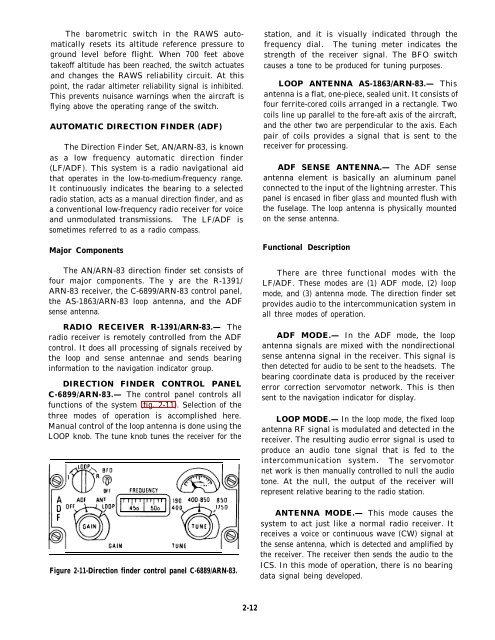Aviation Electronics Technician 1 - Historic Naval Ships Association
Aviation Electronics Technician 1 - Historic Naval Ships Association
Aviation Electronics Technician 1 - Historic Naval Ships Association
Create successful ePaper yourself
Turn your PDF publications into a flip-book with our unique Google optimized e-Paper software.
The barometric switch in the RAWS automaticallyresets its altitude reference pressure toground level before flight. When 700 feet abovetakeoff altitude has been reached, the switch actuatesand changes the RAWS reliability circuit. At thispoint, the radar altimeter reliability signal is inhibited.This prevents nuisance warnings when the aircraft isflying above the operating range of the switch.AUTOMATIC DIRECTION FINDER (ADF)The Direction Finder Set, AN/ARN-83, is knownas a low frequency automatic direction finder(LF/ADF). This system is a radio navigational aidthat operates in the low-to-medium-frequency range.It continuously indicates the bearing to a selectedradio station, acts as a manual direction finder, and asa conventional low-frequency radio receiver for voiceand unmodulated transmissions. The LF/ADF issometimes referred to as a radio compass.Major ComponentsThe AN/ARN-83 direction finder set consists offour major components. The y are the R-1391/ARN-83 receiver, the C-6899/ARN-83 control panel,the AS-1863/ARN-83 loop antenna, and the ADFsense antenna.RADIO RECEIVER R-1391/ARN-83.— Theradio receiver is remotely controlled from the ADFcontrol. It does all processing of signals received bythe loop and sense antennae and sends bearinginformation to the navigation indicator group.DIRECTION FINDER CONTROL PANELC-6899/ARN-83.— The control panel controls allfunctions of the system (fig. 2-11). Selection of thethree modes of operation is accomplished here.Manual control of the loop antenna is done using theLOOP knob. The tune knob tunes the receiver for theFigure 2-11-Direction finder control panel C-6889/ARN-83.station, and it is visually indicated through thefrequency dial. The tuning meter indicates thestrength of the receiver signal. The BFO switchcauses a tone to be produced for tuning purposes.LOOP ANTENNA AS-1863/ARN-83.— Thisantenna is a flat, one-piece, sealed unit. It consists offour ferrite-cored coils arranged in a rectangle. Twocoils line up parallel to the fore-aft axis of the aircraft,and the other two are perpendicular to the axis. Eachpair of coils provides a signal that is sent to thereceiver for processing.ADF SENSE ANTENNA.— The ADF senseantenna element is basically an aluminum panelconnected to the input of the lightning arrester. Thispanel is encased in fiber glass and mounted flush withthe fuselage. The loop antenna is physically mountedon the sense antenna.Functional DescriptionThere are three functional modes with theLF/ADF. These modes are (1) ADF mode, (2) loopmode, and (3) antenna mode. The direction finder setprovides audio to the intercommunication system inall three modes of operation.ADF MODE.— In the ADF mode, the loopantenna signals are mixed with the nondirectionalsense antenna signal in the receiver. This signal isthen detected for audio to be sent to the headsets. Thebearing coordinate data is produced by the receivererror correction servomotor network. This is thensent to the navigation indicator for display.LOOP MODE.— In the loop mode, the fixed loopantenna RF signal is modulated and detected in thereceiver. The resulting audio error signal is used toproduce an audio tone signal that is fed to theintercommunication system. The servomotornet work is then manually controlled to null the audiotone. At the null, the output of the receiver willrepresent relative bearing to the radio station.ANTENNA MODE.— This mode causes thesystem to act just like a normal radio receiver. Itreceives a voice or continuous wave (CW) signal atthe sense antenna, which is detected and amplified bythe receiver. The receiver then sends the audio to theICS. In this mode of operation, there is no bearingdata signal being developed.2-12
















